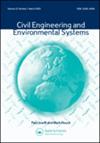多层木结构建筑木混复合楼盖体系的多准则决策分析
IF 1.1
3区 工程技术
Q3 ENGINEERING, CIVIL
引用次数: 6
摘要
摘要:本研究旨在提出一种多准则决策分析(MCDA)方法,用于木混复合地板系统替代设计的综合性能评价。考虑的目标是可使用性和可持续性性能与相关标准,如:(1)弹性和振动方面的舒适等级,(2)建筑质量与相关标准,如开放空间,(3)环境方面与相关标准,如二氧化碳排放,(4)成本方面与相关标准,如总成本。将层次分析法(AHP)和复合比例评价法(COPRAS)作为多准则分析的方法相结合,用于(1)根据调查结果确定准则的权重,(2)验证专家决策矩阵的一致性比率,(3)在候选设计中对最优概念设计进行排序和选择。结果显示,跨度为7.3 m的TCC楼层舒适度等级为A级,排名最高。然而,敏感性分析表明,应选择跨度为9.0 m的舒适a级TCC楼板作为最优概念设计。该研究通过使用AHP结合COPRAS方法来处理有益和非有益的标准,为TCC地板系统开发了一个完整的概念设计工具。本文章由计算机程序翻译,如有差异,请以英文原文为准。
Multi-criteria decision analysis of timber–concrete composite floor systems in multi-storey wooden buildings
ABSTRACT This study aims to present a multi-criteria decision analysis (MCDA) for comprehensive performance evaluation of the alternative design of timber–concrete composite (TCC) floor system. Considered objectives are serviceability and sustainability performance with associated criterion as (1) comfort class regarding springiness and vibrations, (2) architectural quality with associated criterion as open spaces, (3) environmental aspect with associated criterion as CO2 emissions and (4) cost aspect with associated criterion as the total costs. Analytical Hierarchy Process (AHP) and Complex Proportional Assessment (COPRAS) as the methods in the multi-criteria analysis have been combined for (1) determining the weighting of criteria based on the survey results, (2) verifying the consistency ratio of decision matrix made by experts and (3) for ranking and selecting the optimal concept design among design candidates. According to the results, the TCC floor with the span length of 7.3 m belonging to comfort class A has got the highest ranking. However, sensitivity analysis indicates that the TCC floor with a 9.0 m span length belonging to comfort class A shall be selected as the optimal concept design. The study contributes by developing a complete concept design tool for TCC floor systems using AHP combined COPRAS methods to handle both beneficial and non-beneficial criteria.
求助全文
通过发布文献求助,成功后即可免费获取论文全文。
去求助
来源期刊

Civil Engineering and Environmental Systems
工程技术-工程:土木
CiteScore
3.30
自引率
16.70%
发文量
10
审稿时长
>12 weeks
期刊介绍:
Civil Engineering and Environmental Systems is devoted to the advancement of systems thinking and systems techniques throughout systems engineering, environmental engineering decision-making, and engineering management. We do this by publishing the practical applications and developments of "hard" and "soft" systems techniques and thinking.
Submissions that allow for better analysis of civil engineering and environmental systems might look at:
-Civil Engineering optimization
-Risk assessment in engineering
-Civil engineering decision analysis
-System identification in engineering
-Civil engineering numerical simulation
-Uncertainty modelling in engineering
-Qualitative modelling of complex engineering systems
 求助内容:
求助内容: 应助结果提醒方式:
应助结果提醒方式:


